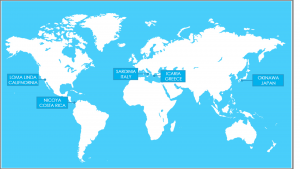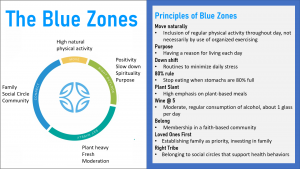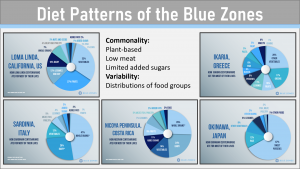5. Living a Long And Healthy Life: Adulthood And Old Age
Many Western cultures such as the US have a negative attitude towards aging. Physical and cognitive decline seems inevitable, while chronic diseases, frailty, and dementia are feared as the final stretch of a long life. Youthful appearance is highly valued which has led to an explosively growing market for anti-aging cosmetics and medical treatment of aging.
In other cultures, aging is revered; older people are valued for their wisdom and are active participants in daily life. An example for this positive view of aging are regions of the world called “Blue Zones” that are characterized by an exceptionally high (healthy) life-expectancy.
The concept of Blue Zones grew out of demographic research published in 2004, in which Sardinia was identified as the region with the highest concentration of male centenarians. Research building on these initial studies identified four more world regions with exceptional longevity. Today, further research has led to the identification of even more regions and communities that qualify as Blue Zones.

Studying Blue Zones and their occupants can give us a holistic look into the lifestyle factors associated with living a long and high-quality life.
General Principles of Blue Zones

The scientists have identified nine lifestyle principles Blue Zones have in common:
- Move naturally: The first principle is referring to an inclusion of regular physical activity. The focus is not necessary on structured exercise but on increasing regular movement such as walking, gardening, and doing housework without mechanical tools reducing the workload.
- Purpose: Older people living in the Blue Zones tend to have a place and purpose in their society. Society provides flexibility that allows the senior to keep working to their ability and fully participate in daily life.
- Down shift: While people in the Blue Zones experience stress they have routines that allow them to release the stress.
- 80% Rule: People only eat until they are 80 % full. This means that they are not hungry but don’t have a feeling of being full. It is thought that being aware of fullness during the day allows for a healthy weight.
- Plant slant: Legumes—beans, lentils, peas, soy—are the cornerstone of the diet providing most of the protein. Meat is eaten only occasionally.
- Wine @ 5: With exception of the Loma Linda Adventist community, other Blue Zone regions drink alcohol moderately and regularly with friends and food, but no binging and weekend excess drinking.
- Belong: The majority of the interviewed seniors belonged to a faith-based community, belief and denomination does not matter.
- Loved ones first: People living in Blue Zones have tight family connections. They invest time and love in their elders, life-partner and children.
- Right tribe: In addition to strong family connections, people living in Blue Zone communities also have social networks that shape and support their healthy lifestyle.
Five Communities Are Identified Blue Zones
Note that all blue zones but one—Loma Linda in California—have a similar theme of being somewhat insulated from our modern life.
Nicoya, Costa Rica is a 80-mile long peninsula. At the center of life is the plan de vida or reason to live. The plan de vida generates a positive outlook among elders and helps keep them active. Nicoyan centenarians frequently visit with neighbors, and they tend to live with families and children or grandchildren who provide support as well as a sense of purpose.
Sardinia, Italy and Icaria, Greece are Mediterranean two Islands with a strong adherence to the Mediterranean diet but also the Mediterranean culture of being physically active and a family centered, relaxed lifestyle.
Okinawa is an island off the coast of Japan. Ikigai is a term used to described purpose and the life is centered around it. Okinawans also maintain a lifelong circle of close friends supporting each other into high age.
Loma Linda, California is a Seventh-Day-Adventist community founded in the 1840 and the only blue zone that is not sheltered geographically. Longevity is attributed to a close-knit community, abstinence from tobacco, alcohol and drugs as we as plenty of physical activity and a vegetarian diet.
While the lifestyle principles of those five world regions are very similar, the diets are determined by regional food availability and culture. All diets are variations of a plant-centered, low meat and low-sugar eating pattern. Within those parameters the eating patterns vary widely.

The Blue Zone research demonstrates that a long, active, healthy life is possible. During the next four chapters you will explore what part of aging is physiological, what factors accelerate aging, and what lifestyle choices can slow down the aging process.
After studying this section you will be able to answer these questions:
- What is an adult? How is an old person defined? What is aging?
- Why do some people age faster than others? What are red flags for accelerated aging?
- Explain physiological and metabolic changes during aging process
- Understand how chronic diseases accelerate the aging process
- Why seniors are at a high risk for malnutrition?
- Can we slow down aging? What are good eating patterns for seniors?


Feedback/Errata